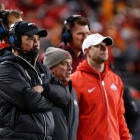
Many years ago, former SEC commissioner Mike Slive considered the prospect of his mighty conference one day expanding to 16 teams. This was way before Texas and Oklahoma -- or any set of superpowers -- thought about humbly knocking on the SEC's front door and asking for a meeting.
Back then, after considering it for a moment, the commissioner didn't like the idea. With 16 teams, Slive said, the SEC would cease to look like a conference but rather two far-flung eight-team leagues playing under a common banner. Less personal, he suggested. Think along these corporate lines: The same company that wires your loved one bouquets (1-800-Flowers) also makes Moose Munch premium popcorn.
As we ease into Week 3 of the 2021 college football season, we shouldn't have to be reminded the SEC is already a corporate giant. Being a football giant is complicated enough.
No. 1 Alabama travels to No. 11 Florida on Saturday for the first time in 10 years. In the SEC, that gap hardly qualifies as lengthy. In 2019, Alabama visited South Carolina for the first time in nine years. Georgia still hasn't travelled to play Texas A&M since the Aggies joined the league in 2012.
Don't be surprised: It currently takes SEC teams 12 years to cycle through the entire conference home and away.
How, then, is familiarity going to improve with the addition of Texas and Oklahoma? The Longhorns and Sooners joining the SEC will mark just the second-time in major-college football history that a 16-team conference has formed. The old Western Athletic Conference played with 16 from 1996-98 until it collapsed in on itself.
No one is suggesting that as the SEC's fate. Quite the opposite. It became a superconference almost by accident when Texas and Oklahoma called. It was painful and sudden. But when the recriminations are done, the SEC will still have the most, best college football brands ever in one league.
Its traditional rivalries already might total more than the rest of FBS combined: Alabama-Auburn, Florida-Georgia, Auburn-Georgia, Alabama-Tennessee, Oklahoma-Texas, etc. But that's part of the problem. Some of those rivalries stand in the way of SEC teams playing each other more often.
What is a league when all the participants don't see each other on a regular basis?
"For sure we're going to have to create more rotation. That's the key," said Florida athletic director Scott Stricklin. "We've got to have fewer permanent opponents so we can get more rotation and see these type of games more often."
Since 2012, the SEC has played a 6-1-1 conference format. A team will play all six opponents from its seven-team division, one permanent crossover opponent from the other division and a rotating opponent from that division. That means seven of the eight games are the same every year. It also means, in any given year, SEC teams are playing only 61% of the conference.
That's the same small ratio as the ACC, but comparisons aren't important here. As mentioned, the SEC already has more, better games than anyone. Because of that, the scheduling warehouse is full. The question is logistics.
Because the SEC falls way short of a full round-robin schedule -- only the Big 12 has one among FBS conferences -- Stricklin has already seen tiebreaker issues ahead. In a 16-team league, the typical first tiebreaker, head-to-head results, isn't always going to be available.
"You never want it to come down to a coin flip," Stricklin said. "We have to figure out a way to break ties. We have to look at the number of [conference] games. We have to look at the number of permanent opponents. Hopefully, we put a priority on seeing teams as much as possible."
That means some hard decisions will be made. It has already been whispered that Alabama-Tennessee -- the traditional Third Saturday in October matchup -- may be one of adjustments. The game accounts for each team's permanent crossover. It has been played 103 times since the series started in 1901, but meeting annually seems less compelling in 2021. Tennessee has contributed little to the rivalry lately, losing a series-record 14 in a row to Bama by an average of 26 points.
Auburn and Florida played each year -- except for World War II -- from 1927 to 2002. At the beginning of the century, the SEC was a 12-team league that played five division games, two permanent crossovers and one rotating opponent. A switch to a 5-1-2 format allowed for more variety from the opposite division.
In 2012, that 6-1-1 format debuted. Some SEC teams became strangers. After 2011, Auburn-Florida wasn't played again until 2019. Florida's current annual crossover game against LSU, which has been played every season since 1971, may be on the chopping block just like Alabama-Tennessee.
"With change comes discomfort," Florida coach Dan Mullen said. "There's always been that. When the SEC went to divisions a long time ago, I thought Florida-Auburn was one of the oldest rivalries in the South. Then you didn't play that game anymore. Then they came here a couple of years ago, and it was a huge game."
Alabama and Florida have actually played four times since the Crimson Tide's last visit to Gainesville, Florida, in 2011. Three of them have been by chance, though, in the 2015, 2016 and 2020 SEC Championship Games. There's going to be a special kind of noise in The Swamp on Saturday afternoon. The Gators haven't beaten the Tide on Florida Field since 2006.
SEC expansion has played right into Nick Saban's wheelhouse. For years, Alabama's coach has advocated for more conference games, even an all-Power Five schedule. Advocates of that approach were bolstered by last year's SEC-only 10-game regular-season schedule during COVID-19.
"Ever since we went to more teams in the SEC, the only way you're going to play everybody is to play more SEC games," Saban said. "I've been an advocate of that for some time with very little support. I don't know how you do it without playing more SEC games."
That's one of the options on the board. Current SEC commissioner Greg Sankey has called for a complete overview of the conference scheduling philosophy. That includes everything from addressing the permanent crossover games to adding one -- maybe two -- conference games. Plus, the composition of the SEC's divisions will need to be discussed.
"I've asked our campus leaders to think about the big-picture, blue-sky thinking," Sankey said. "We are open to a variety of alternatives. We want to rotate teams through our campuses with greater frequency. That's a bit of a principle. We're not waiting for 12 years for one side of the conference to visit the other."
The irony of scheduling philosophies further reflects the lack of Power Five unity. In the so-called Alliance, the Big Ten, ACC and Pac-12 are discussing playing nonconference games against one another. The Big Ten and Pac-12 have talked about reducing their conference schedules from nine to eight games to accommodate those made-for-TV clashes. That's their way of improving their schedules.
If the SEC adds just one conference game, moving to nine in a 16-team league, its schools would be playing only 56% of the members annually. Yet, they would arguably improve their overall schedule strength.
Conference scheduling creativity will also have to consider the potential monster games that would be generated with the addition of Texas and Oklahoma matching up against the likes of Alabama, Florida, Georgia, LSU and Texas A&M.
Plus, everyone in the SEC will want Texas and Oklahoma to play on their campuses as soon as possible. Is it possible, then, the league may have too many good teams?
The SEC is the only conference where that question can be asked -- and answered.
















